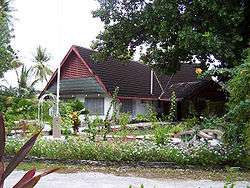Demographics of Kiribati
| Demographics of Kiribati | |
|---|---|
| Population | 103,058 (2010) |
This article is about the demographic features of the population of Kiribati, including population density, ethnicity, education level, health of the populace, economic status, religious affiliations and other aspects of the population.
Population
| Historical population | ||
|---|---|---|
| Year | Pop. | ±% |
| 1921 | 3,122 | — |
| 1931 | 29,751 | +852.9% |
| 1947 | 31,513 | +5.9% |
| 1963 | 43,336 | +37.5% |
| 1973 | 51,926 | +19.8% |
| 1978 | 56,213 | +8.3% |
| 1985 | 63,883 | +13.6% |
| 1990 | 72,335 | +13.2% |
| 1995 | 77,658 | +7.4% |
| 2000 | 84,494 | +8.8% |
| 2005 | 92,533 | +9.5% |
| 2010 | 103,058 | +11.4% |
| Source: [1][2] | ||
Geographic locations
| | |||||||||
|---|---|---|---|---|---|---|---|---|---|
| Rank | Name | Island | Pop. | ||||||
 Betio  Bikenibeu |
1 | Betio | Betio | 15,755 |  Teaoraereke  Bairiki | ||||
| 2 | Bikenibeu | South Tarawa | 6,568 | ||||||
| 3 | Teaoraereke | South Tarawa | 4,171 | ||||||
| 4 | Bairiki | South Tarawa | 3,524 | ||||||
| 5 | Temwaiku | South Tarawa | 3,135 | ||||||
| 6 | Eita | South Tarawa | 3,061 | ||||||
| 7 | Bonriki | South Tarawa | 2,355 | ||||||
| 8 | Tabwakea | Kiritimati | 2,311 | ||||||
| 9 | Ambo, Kiribati | South Tarawa | 2,200 | ||||||
| 10 | Causeway | South Tarawa | 2,054 | ||||||
CIA World Factbook demographic statistics
The following demographic statistics are from the CIA World Factbook, unless otherwise indicated.
Nationality
noun:
I-Kiribati (singular and plural)
adjective:
I-Kiribati
Ethnic groups
Micronesian 99.1% (2000 census)
Religions
Roman Catholic 55%, Protestant (Congregational) 40%, other: Seventh-day Adventist, Muslim, Bahá'í, Church of God, The Church of Jesus Christ of Latter-day Saints (1999) - see Religion in Kiribati
Languages
English (official) and Gilbertese (common language).
Population
103,248 (July 2013 est.)
Age structure
- 0–14 years: 38.5%
- 15–64 years: 58.1% (male 30,216/female 31,004)
- 65 years and over: 3.4% (male 1,517/female 2,027) (2006 est.)
Median age
- total: 23.2 years
- male: 22.4 years
- female: 24.1 years (2013 est)
Population growth rate
1.21% (2013 est.)
The population grew by 78% from 52,000 in 1973 to 93,000 in 2005,[4] an annual average growth rate of 1.8%.
Birth rate
22.18 births/1,000 population (2013 est.)
Death rate
7.24 deaths/1,000 population (2013 est.)
Net migration rate
-2.86 migrant(s)/1,000 population (2013 est.)
Urbanization
- urban population: 44% of total population (2010)
- rate of urbanization: 1.9% annual rate of change (2010-15 est.)
Sex ratio
at birth: 1.05 male(s)/female
under 15 years: 1.03 male(s)/female
15–64 years: 0.98 male(s)/female
65 years and over: 0.75 male(s)/female
total population: 0.99 male(s)/female (2006 est.)
Maternal mortality rate
9.0 deaths/100,000 live births (2008)
Infant mortality rate
total: 36.50 deaths/1,000 live births
male: 37.74 deaths/1,000 live births
female: 35.21 deaths/1,000 live births (2013 est.)
Life expectancy at birth
total population: 65.11 years
male: 62.70 years
female: 67.64 years (2013 est.)
Total fertility rate
2.63 children born/woman (2013 est.)
Health expenditures
11.3% of GDP (2010)
Physicians density
0.3 physicians/1,000 population (2006)
Hospital bed density
1.4 beds/1,000 population (2010)
Obesity - adult prevalence rate
46% (2008)
Education expenditures
11.6% of GDP (2002)
Literacy
definition:
NA
total population:
NA%
male:
NA%
female:
NA%
References
- ↑ http://www.spc.int/prism/country/ki/stats/CensusSurveys/popchart.htm
- ↑ http://www.mfed.gov.ki/wp-content/uploads/2011/05/Census-Report-2010-Volume-1.pdf
- ↑ Kiribati National Statistics Office 2010, pp. 34–50
- ↑ http://www.motu.org.nz/files/docs/Motu_presentation_bedford.pdf
![]() This article incorporates public domain material from websites or documents of the CIA World Factbook.
This article incorporates public domain material from websites or documents of the CIA World Factbook.
| |||||||||||||||||||||||||||||
| ||||||||||||||
